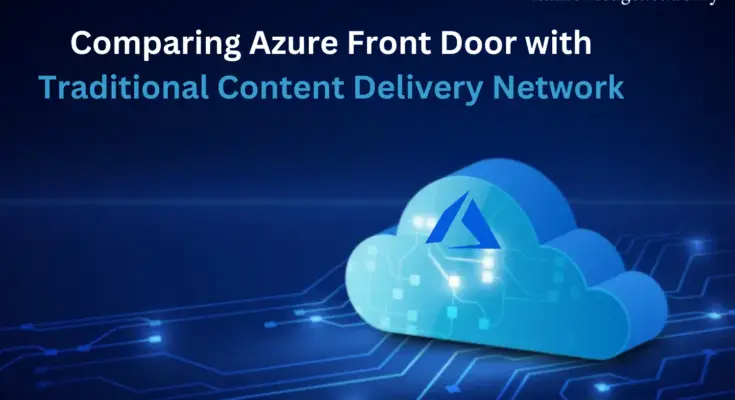Reliability, security, and speed are essential in digital environment, and how content is delivered can significantly impact user experience. Traditional Content Delivery Networks (CDN) have long been fundamental in web content distribution, reducing latency by caching static assets close to users. For professionals looking to enhance their skills through a Microsoft Azure Certification, understanding the shift from traditional CDN to more advanced solutions are crucial. As digital demands evolve, businesses must also adapt. Enter Azure Front Door,a cutting-edge cloud native technology that provides enhanced security for complex web applications, intelligent traffic routing, dynamic content acceleration, and efficient content delivery.
This blog explores the differences of Azure Front Door and traditional CDN, offering insights on selecting the best option to optimise your online presence.
Table of Contents
- What is Azure Front Door?
- What is a Traditional CDN?
- Key Differences Between Azure Front Door and Traditional CDN
- Conclusion
What is Azure Front Door?
Azure Front Door is a contemporary, scalable, cloud native application delivery network (ADN) service offered by Microsoft Azure. It provides content delivery, application acceleration, and global load balancing. In contrast to conventional CDN, Azure Front Door is integrated into the Azure ecosystem and offers deep cloud-native features, including performance optimisation, security, and intelligent routing.
Key Features
- Global Load Balancing: Ensuring optimal resource utilisation, global load balancing provides Layer 7 for HTTP and HTTPS traffic.
- Dynamic Content Acceleration: Azure Front Door enables data transmission from the closest Point of Presence (PoP) and speeds up dynamic content delivery via Anycast.
- Intelligent Traffic Routing: Intelligent traffic routing supports multiple traffic routing techniques including priority-based, weighted-round-robin, and latency-based routing.
- Built-in Security: Integrated Security provides Secure Sockets Layer [SSL] offloading, DDoS protection, and a Web Application Firewall [WAF] to improve web application security.
- Deep Integration with Azure Services: Integrates with Azure Security Centre, Azure Monitor, and Azure DevOps easily.
What is a Traditional CDN?
A CDN is a collection of servers situated worldwide that assists in the delivery of web content by caching the static files of objects closer to the intended users. Quite older CDN service providers are Akamai, CloudFlare, and Amazon CloudFront, which play a significant role in web infrastructure.
Key Features
- Content Caching: Minimising latency and load times by caching static content like stylesheets, movies, and photos.
- Geographic Distribution: CDN guarantee that material is delivered from the location closest to the end user, minimising latency, thanks to their global network of servers.
- DDoS Protection: CDN distribute traffic loads among several servers, offering fundamental security measures, such as protection against Distributed Denial of Service (DDoS).
- Content Delivery: Traditional CDN primary function is static content delivery. Although they are capable of handling dynamic content, this is not their main area of interest.
Key Differences Between Azure Front Door and Traditional CDN
Although Azure Front Door and conventional CDN enhance online performance and content delivery, their approaches, capabilities, and use cases differ. This is a thorough comparison:
Content Delivery vs Application Delivery
Conventional CDN cache static assets closer to users, with the primary goal of facilitating content delivery. Conversely, Azure Front Door is not limited to content distribution. It is an application delivery network perfect for contemporary online applications with intricate architectures because it is made for load balancing, dynamic content acceleration, and intelligent routing.
Traffic Routing Capabilities
Conventional content delivery networks often employ fundamental routing methods, like latency-based and geographic routing, to maximise content delivery. Azure Front Door offers more advanced routing techniques, such as path-based, multi-site, and URL-based routing. These features help developers improve speed and reliability by tailoring traffic routing to the needs of individual applications.
Integration and Management
Because of its extensive integration with the Azure ecosystem, Azure Front Door may seamlessly connect to other Azure services, such as Azure Functions, Azure App Service, and Azure Kubernetes Service (AKS). Robust integration facilitates enhanced administration and monitoring functionalities. On the other hand, complicated configurations and extra tools could be needed for traditional CDN to integrate and administer cloud services.
Security Features
Azure Front Door provides basic DDoS protection, as do conventional CDN. But with its integrated Web Application Firewall (WAF), SSL/TLS offloading, and bot defence features, Azure Front Door goes above and beyond security. Because of these cutting-edge security features, Azure Front Door is a superior alternative for companies with stricter security and compliance requirements.
Dynamic Content Handling
When it comes to caching and delivering static content, traditional content delivery networks (CDN) perform better than dynamic content that is updated often. By utilising Anycast and TCP Anycast, Azure Front Door offers dynamic content acceleration, lowering latency and enhancing performance for dynamic online applications.
Cost and Pricing Models
Conventional CDN frequently use a simpler pricing structure based on requests and data transmission. Azure Front Door employs a more intricate price structure incorporating SSL connections, routing rules, and data transmission. Companies must evaluate their demands thoroughly to choose the most economical course of action.
Conclusion
The decision between Azure Front Door and a conventional CDN is based on company goals, technological specifications, and financial constraints. Azure Front Door provides a complete solution for dynamic content distribution, security, and intelligent traffic management in a cloud-native environment. In contrast, typical CDN are particularly successful in static content delivery. By leveraging resources from The Knowledge Academy, businesses can make educated judgements and be aware of these distinctions to improve their online apps’ performance, security, and dependability.



